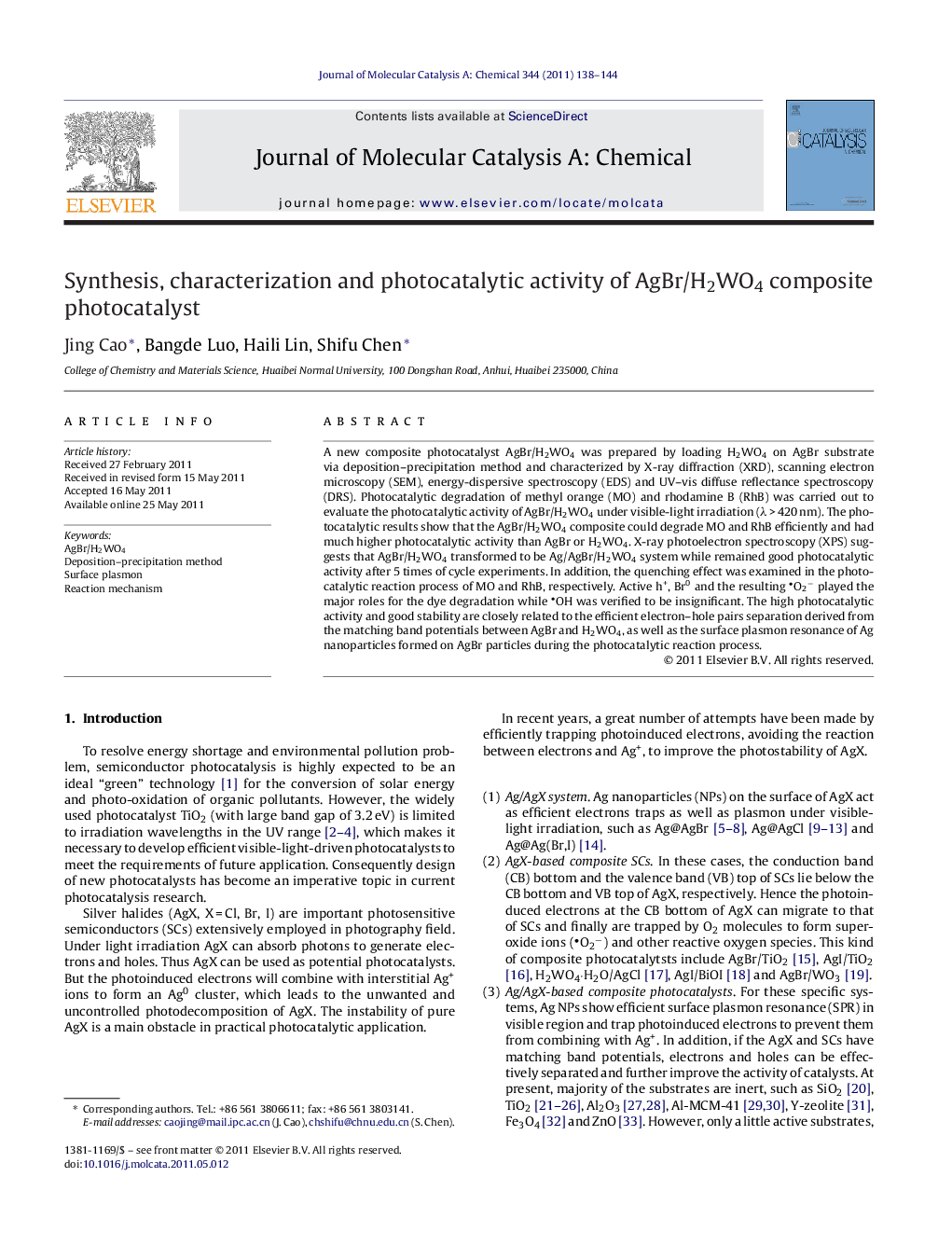| کد مقاله | کد نشریه | سال انتشار | مقاله انگلیسی | نسخه تمام متن |
|---|---|---|---|---|
| 66376 | 48428 | 2011 | 7 صفحه PDF | دانلود رایگان |

A new composite photocatalyst AgBr/H2WO4 was prepared by loading H2WO4 on AgBr substrate via deposition–precipitation method and characterized by X-ray diffraction (XRD), scanning electron microscopy (SEM), energy-dispersive spectroscopy (EDS) and UV–vis diffuse reflectance spectroscopy (DRS). Photocatalytic degradation of methyl orange (MO) and rhodamine B (RhB) was carried out to evaluate the photocatalytic activity of AgBr/H2WO4 under visible-light irradiation (λ > 420 nm). The photocatalytic results show that the AgBr/H2WO4 composite could degrade MO and RhB efficiently and had much higher photocatalytic activity than AgBr or H2WO4. X-ray photoelectron spectroscopy (XPS) suggests that AgBr/H2WO4 transformed to be Ag/AgBr/H2WO4 system while remained good photocatalytic activity after 5 times of cycle experiments. In addition, the quenching effect was examined in the photocatalytic reaction process of MO and RhB, respectively. Active h+, Br0 and the resulting O2− played the major roles for the dye degradation while OH was verified to be insignificant. The high photocatalytic activity and good stability are closely related to the efficient electron–hole pairs separation derived from the matching band potentials between AgBr and H2WO4, as well as the surface plasmon resonance of Ag nanoparticles formed on AgBr particles during the photocatalytic reaction process.
A novel composite photocatalyst AgBr/H2WO4 was prepared via simple deposition–precipitation method. The AgBr/H2WO4 composites degraded methyl orange (MO) and rhodamine B (RhB) more efficiently under visible-light irradiation (λ > 420 nm) over single AgBr or H2WO4. AgBr/H2WO4 transformed to be Ag/AgBr/H2WO4 system at the early reaction process while remained good photocatalytic activity after 5 times of cycle experiments. Active h+, Br0 and the resulting O2− played the major roles for the dye degradation while OH was verified to be insignificant. The high photocatalytic activity and good stability are closely related to the efficient electron–hole pairs separation derived from the matching band potentials between AgBr and H2WO4, as well as the surface plasmon resonance of Ag nanoparticles formed on AgBr particles during the photocatalytic reaction process.Figure optionsDownload high-quality image (121 K)Download as PowerPoint slideHighlights
► AgBr/H2WO4 was synthesized by using a facile deposition–precipitation method.
► AgBr/H2WO4 displays excellent visible-light photocatalytic activity (λ > 420 nm).
► AgBr/H2WO4 possesses good stability after successive 5 cycle experiments.
► The resulting O2−, Br0 and h+ played the major roles for MO and RhB degradation.
Journal: Journal of Molecular Catalysis A: Chemical - Volume 344, Issues 1–2, 17 June 2011, Pages 138–144